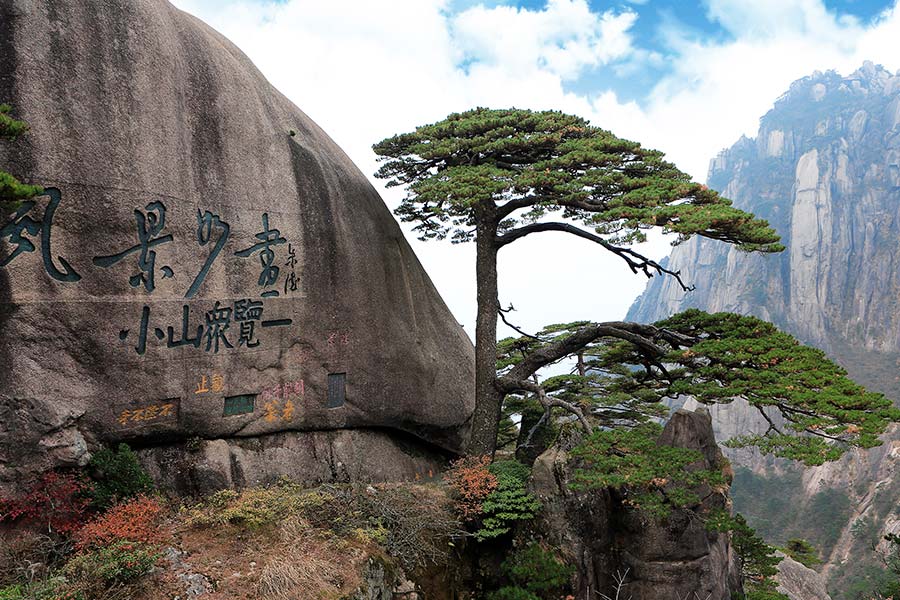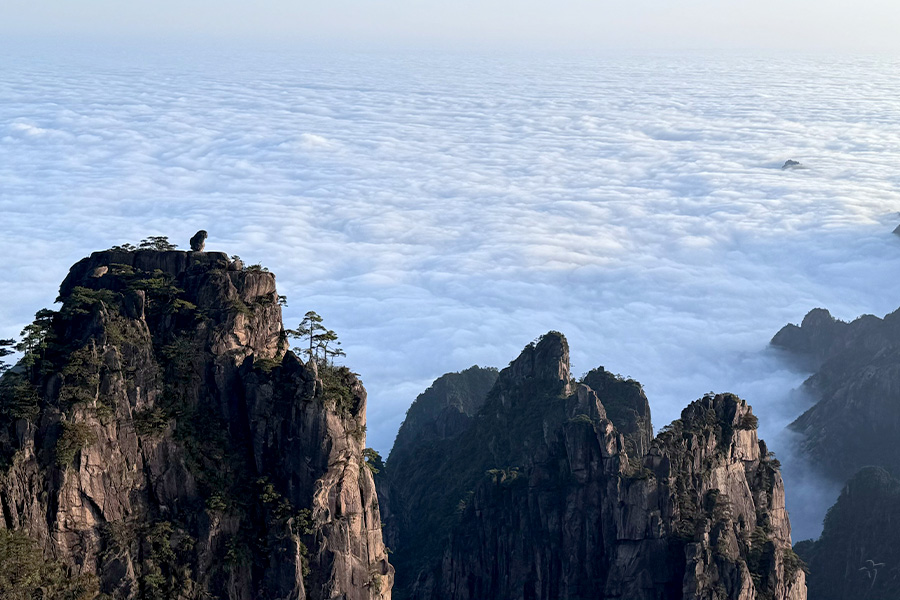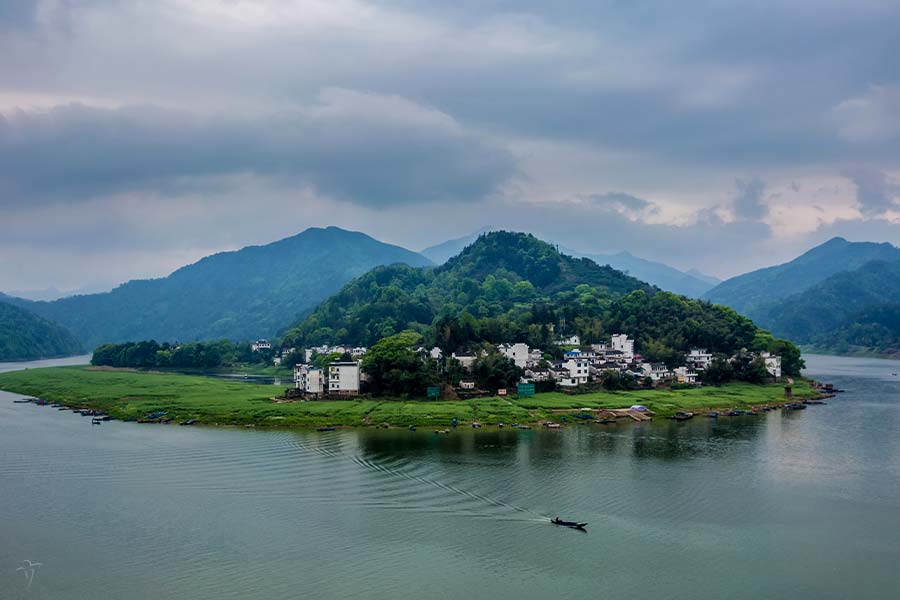Yellow Mountain
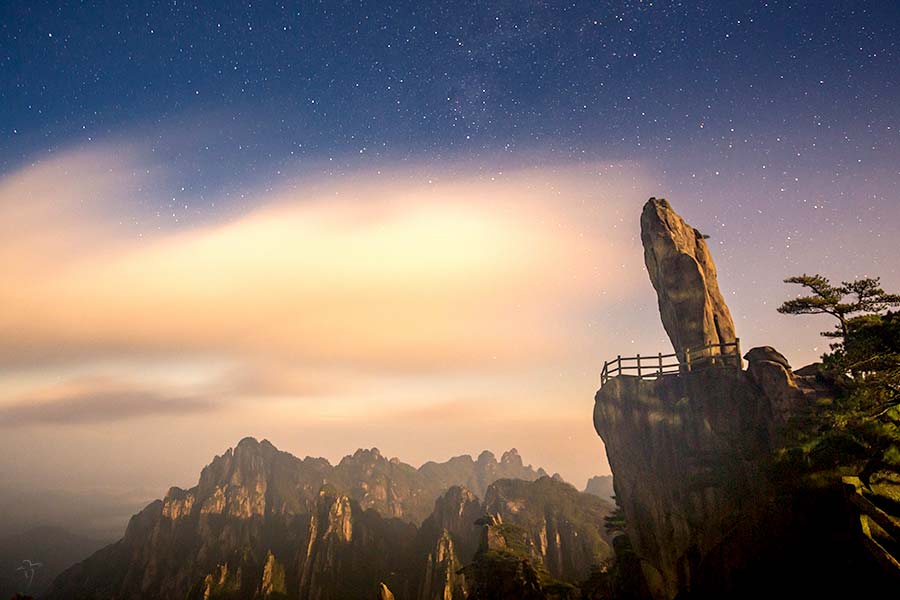
· In 1985, Yellow Mountain was elected as one of Top 10 Scenic Areas of China;
· In December of 1990, Yellow Mountain was listed on the list of World Cultural and National Heritage;
· In February of 2004, Yellow Mountain was selected as World Geological Park;
· In May of 2007, Yellow Mountain was listed as National 5A Scenic Area by China National Tourism Administration;
· In 2009, the Guest-greeting Pine of Yellow Mountain won the prize of "the First Pine of China" awarded by China World Records Association.
By virtue of distinguishingly grand views, Mt. Taishan (泰山) in Shandong, Mt. Huashan (华山) in Shaanxi, Mt. Songshan (嵩山) in Henan, Mt. Hengshan (恒山) in Shanxi and Mt. Hengshan (衡山) in Hunan, are universally accepted as the Five Great Mountains of China since the ancient times. However, "One who has returned from the Five Great Mountains thinks nothing of other mountains, and he who has been to Yellow Mountain (also called Mt. Huangshan) thinks nothing of the Five Great Mountains" – this famous Chinese saying shows the unique charm of the fairyland-like Yellow Mountain located in Huangshan City of Anhui.
Yellow Mountain has been being treated as the Holy Land of Taoism since ancient China because of its amazing tranquility and natural beauty, to this day many Taoist relics such as Taoist temples still can be found on the mountain. It is said that the Chinese immemorial Yellow Emperor (Huang Di) used to refine his elixir in Yellow Mountain, which makes the mountain more mysterious and respected. Four thousands of years, Yellow Mountain has been being hailed as "the Most Peculiar Mountain under the Heaven", vividly featuring "four wonders" – odd-shaped pines, peculiar rock peaks, delightful hot springs, and amazing cloud sea. Stretching for around 154 square kilometers, the whole Yellow Mountain Scenic Area is made up of 6 scenic zones.
1. Yellow Mountain Hot Spring Resort
The Yellow Mountain Hot Spring Resort was named Tao Yuan Xian Jing in ancient time, which means "the Fairy Land of Peach Blossom". With the Lansheng Bridge as the center and the Peach Stream and the Xiaoyao Stream running through, today the resort has become one of the four tourist reception centers of Yellow Mountain.
This area is 1.5 kilometers away from the entry (Ciguang Pavilion) of Yellow Mountain Scenic Area, which takes about 30 minutes' walk; and it is 7 kilometers apart from another entry (Yungu Temple), tourists can take a tourist bus come and go between the resort and Yungu Temple. Generally, this hot spring resort is a must-pass for Yellow Mountain tour.
Main Scenic Spots in Yellow Mountain Hot Spring Resort: Renzi Waterfall, Sandiequan Waterfall, Mingxianquan Spring, Danjing Well, Zuishi Stone, Ciguang Pavilion (Ciguang Pavilion is a hundreds of years old temple and now functions as the front entry of the Yellow Mountain Scenic Area as well as the entry of the Yuping Cableway).
2. Yuping Scenic Area (Jade Screen Scenic Area)
As the front range of Yellow Mountain Scenic Area, the Yuping Scenic Area is a nice fairyland gathering a lot of natural wonders such as the well-known Guest-greeting Pine. Between the Lianhua Peak (Lotus Peak) and the Tiandu Peak (Heavenly Capital Peak) sits the Yuping Building (Jade Screen Building) which is the center as well as the best viewing deck of Yuping Scenic Area. Apart from the all-over natural beauties, the Yuping Scenic Area is also famous for its treasured stone inscription by Chairman Mao Zedong, Marshal Zhu De and Marshal Liu Bocheng.
Lianhua Peak (Lotus Peak): the highest peak of the Yellow Mountain Scenic Area. This lotus-like peak is at a sea-level of 1864 meters and along the path is full of beautiful pines and azaleas. The top of the peak is also a wonderful viewing stand, on which tourists can have a panoramic view of the around scenery on sunny day and enjoy the romantic mist after rain.
Tiandu Peak (Heavenly Capital Peak): one of the three main peaks at a sea-level of 1830 meters. The path along this peak was originally extremely precipitous, but later the road has been well repaired and looks not that heart-stopping.
Aoyu Peak (Big Turtle Peak): just like its name shows, this peak is a huge turtle-shaped peak at a sea-level of 1780 meters. Below this peak it is the Tianhai Valley where live a large amount of rare plant species. Taking advantage of that, the botanical department of Yellow Mountain has created the Tianhai High Mountain Botanical Garden there. Nearby the Tianhai Valley there are some famous spots like Haixin Pavilion and Phoenix Pine.
3. Beihai Scenic Area (North Sea Scenic Area)
Embraced by the Shixin Peak, Shizi Peak (Lion Peak) and Bai'e Peak (White Goose Peak), the Beihai Scenic Area is the interior of Yellow Mountain Scenic Area. Gathering wonderful views of peaks, rocks, stone bridge, platform, pines and cloud sea, Beihai Scenic Area is a color-changing viewing window by nature. The Qingliang Flat (Cool Flat) on the Shizi Peak is thought to be the most ideal place for watching cloud sea, sunrise and sunset. Being a highland scenic area surrounding the Beihai Hotel, this scenic spot is another tourist reception center of Yellow Mountain Scenic Area.
In this amazing moorstone mountain area, there is a romantic site where couples can lock a love-lock together, which symbolizes the determination of never leaving each other.
4. Baiyun Scenic Area (White Cloud Scenic Area)
Baiyun Scenic Area is situated at the west of Yellow Mountain Scenic Area. This area centers around the Diaoqiao Nunnery (or called Baiyun Nunnery) which was initially a Buddhist one in Ming Dynasty and later was changed into a Taoist one in Qing Dynasty. Around the nunnery are towering pines, clear streams and beautiful waterfalls, which draw a quiet and beautiful scene.
In a bid to connect the Baiyun Scenic Area, the Songgu Scenic Area and the Beihai Scenic Area, another scenic spot – Xihai Canyon (West Sea Canyon) was developed, with marvelous peaks standing in cloud and mist.
5. Songgu Scenic Area (Pine Valley Scenic Area)

Located at the north side of Yellow Mountain Scenic Area, Songgu Scenic Area contains the the Shizi Peak (Lion Peak), Luotuo Peak (Camel Peak), Shuxiang Peak (Bookcase Peak) and Baota Peak (Pagoda Peak). Just like other scenic areas in Yellow Mountain, this area is full of fresh air and is decorated with crystal streams, fantastic waterfalls and peaks, green trees and bamboos and rare flowers. Historic buildings such as the Lotus House and the Songgu Buddhist Temple dots among the Furong Peak (Lotus Peak), Danxia Peak, Songlin Peak (Pine Forest Peak), Shuangshun Peak (Double Bamboo Peak) and waterscapes, which makes it a good place to cultivate one's moral character.
If tourists arrive at the North Entry of Yellow Mountain, it is suggested to start the tour from the Furong Mountain (Lotus Mountain).
6. Yungu Scenic Area (Cloud Valley Scenic Area)
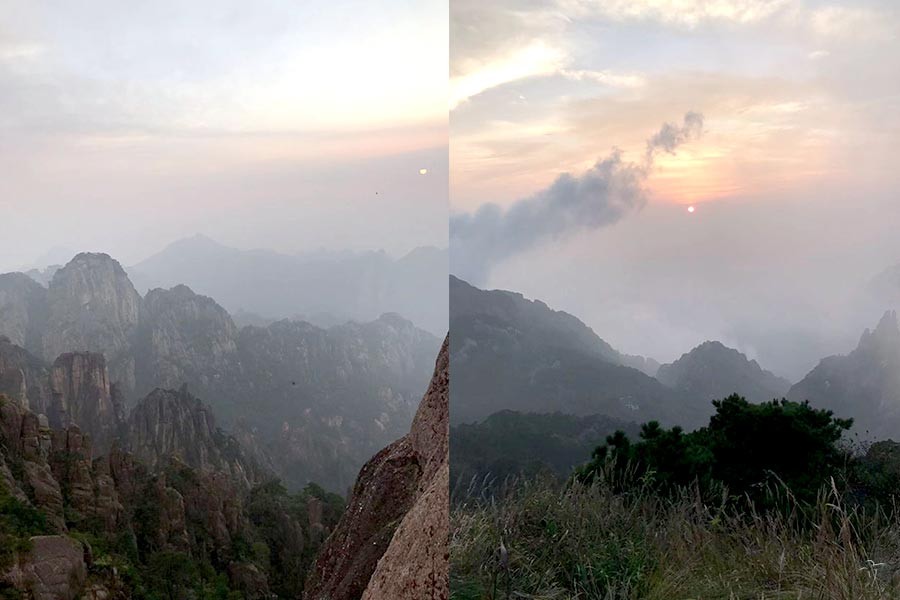
Yungu Scenic Area is an open valley sitting at the east of Yellow Mountain Scenic Area. Cheng Yuanfeng, one prime minister of Song Dynasty in ancient China, used to spend his study time there, therefore, the area is also named Prime Minister Fountain.
Yungu Manor, Ancient Tree, fantastic rock peaks, Jiulong Waterfall (Nine Dragons Waterfall) and Baizhang Stream are the major scenes in Yunggu Scenic Area.
Best Viewing Locations on Yellow Mountain
1. Best places for sunrise watching on Yellow Mountain
Qingliang Flat, Shuguang Pavilion, Lion Peak, Shixin Peak, Danxia Peak, Guang Ming Ding (Bright Summit), Big Turtle Peak, Yuping building (Jade Screen Building).
2. Best places for sunset watching
Paiyun Pavilion, Danxia Peak, Flying Stone, Guang Ming Ding (Bright Summit), Lion Peak.
3. Best places for cloud sea watching
Yuping building (Jade Screen Building), Qingliang Flat, Bai'e Ling (White Goose Mountain), Paiyun Pavilion, Guang Ming Ding (Bright Summit).
4. Best places for snow watching
Beihai(North Sea) Scenic Area, Xihai(West Sea) Scenic Area, Tianhai Scenic Area, Yuping building (Jade Screen Building), Songgu (Pine Valley), Yungu (Cloud Valley), Hot Spring Scenic Area.
Climate of Yellow Mountain
The Yellow Mountain Scenic Area locates in the zone of a subtropical monsoon climate. Due to its high elevation, climate from the foot to the top of the mountain differs vertically and changeable weather is common on the mountain; it has the average air temperature of 7.8℃, with a highest temperature of 27℃ in summer and a lowest air temperature of -22℃ in winter; Besides, Yellow Mountain is endowed with plentiful rainfall which usually falls from April to June; and in winter tourists can enjoy the breathtaking snowy mountain scenery for around 40 days.
Best Time to Visit Yellow Mountain
① Spring (March - May): To enjoy blossom of all sorts of flowers and bird singing.
② Summer (June - August): To appreciate the characteristic Yellow Mountain pines, cloud sea and avoid the summer heat.
③ Autumn (September - November): To watch a colorful world mixed of green pine, gray rocks, red maples and yellow chrysanthemums.
④ Winter (December - February): To take a Yellow Mountain Winter Tour to shoot the breathtaking snow and rime scenes.
Yellow Mountain Travel Tips
1. If you choose to tour Yellow Mountain by foot, it is suggested to start from Yungu Temple (it will save your physical strength than starting from other places). If you choose to visit Yellow Mountain by cable car, it is suggested to set off from Ciguang Pavilion (it takes about 10 minutes to get uphill by cable car).
2. Get accommodation at Yuping Building is very convenient for get uphill because of the Yuping Cableway. If you just plan to stay one night on the mountain, it is suggested to stop in Beihai Scenic Area or Xihai Scenic Area.
3. To avoid losing too much physical strength, take along luggage as light as possible. But it is necessary to take along some clothes, as it is cold in the morning and night on the mountain.
4. The weather of Yellow Mountain is changeable, therefore it is necessary to take along a raincoat (umbrella is not suitable).
5. Do not climb high peaks, especially the Tiandu Peak and Lotus Peak; do not touch the iron chains along the paths; do not stand under the tree n case of lightning stroke.
6. It is suggested to wear climbing boots and gym shoes when climbing. In consideration of security, it is suggested to buy a walking stick, which will do help to the climbing.
7. The mountains are high and the paths are steep, so do not walk too fast while climbing. Have a rest if you feel rotten or your heart beat over fast.
Attractions around Yellow Mountain
Fei Cui Gu(Jade Valley), Jiu Long Pu Bu (Nine Dragons Waterfall), Xidi Ancient Village, Hongcun Ancient Village, Huizhou Ancient Town, Huashan Mountain Mysterious Cave, Memorial Archways, Bao Family's Garden, Taiping (Peace) Lake Scenic Area, Qiandao (Thousand Islands) Lake Scenic Area, etc.
Huangshan tours
Quick Questions
Our team is waiting for your questions. Please feel free to ask us any questions you might have about our China package tours, Chinese culture, or the sites available. We will gladly help you with any special needs you might have and all questions, like our trip designing is completely free of charge.



